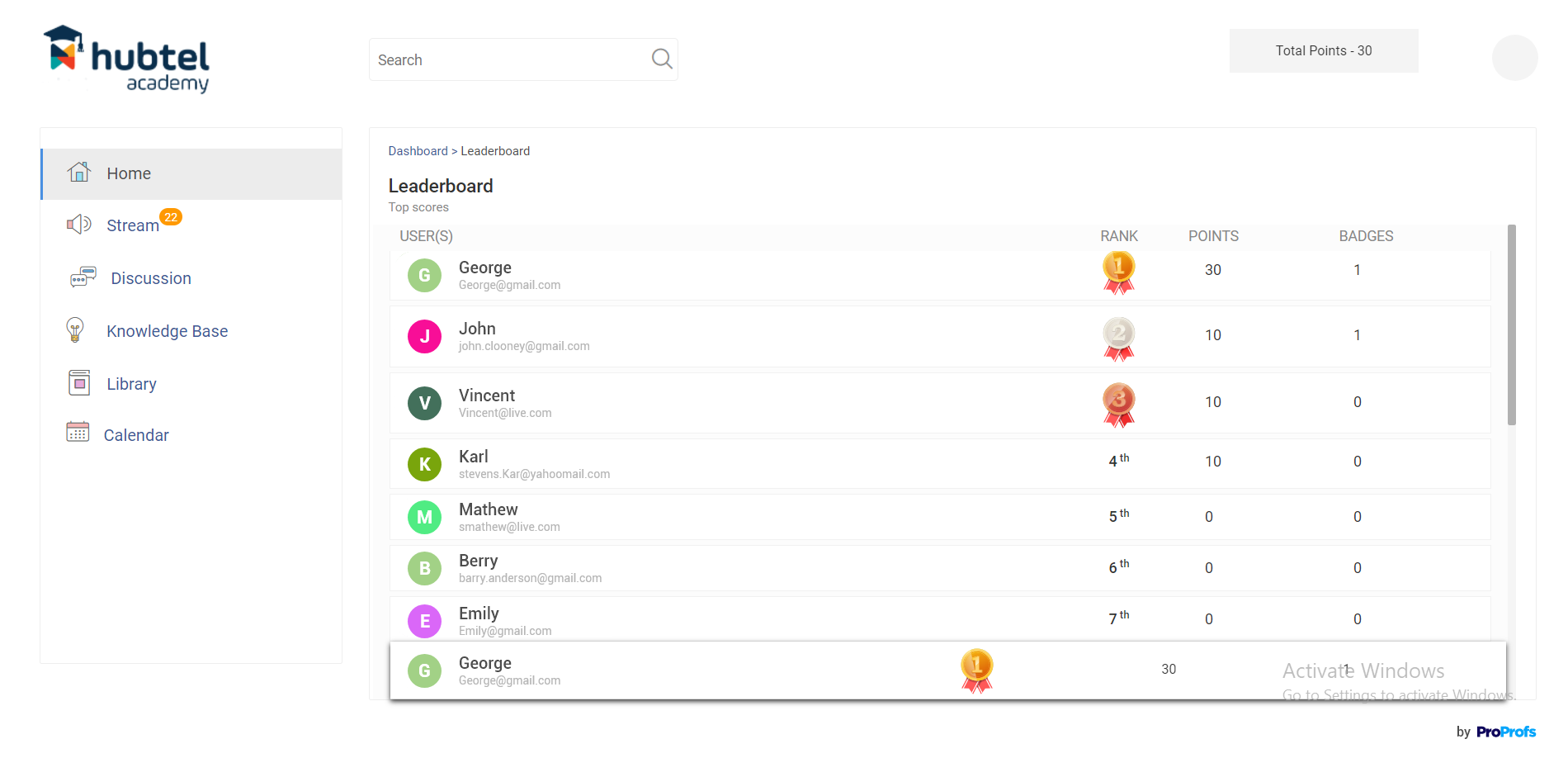I know how essential it is to keep myself posted about eLearning trends since I’m actively involved with the online training and learning industry.
I believe it is the same case with you. Knowing the direction and the future of eLearning is key to your business strategies. It is about staying competitive and relevant.
To ensure you don’t miss out on what’s trending and upcoming in the eLearning industry, here is what you need to watch out for in 2025 and beyond.
15 eLearning Trends Shaping How People Teach & Learn
Find out what’s unfolding fast in the world of eLearning so that you can be a part of it.
- Mobile Learning
- Artificial Intelligence
- Augmented & Virtual Reality
- Gamification
- Microlearning & Nano Learning
- Personalized Learning
- Blended Learning
- Remote Learning
- Video-Based Learning
- Data Analysis
- Content Curation
- Social Learning
- Focus on Soft Skills
- Membership & Subscription-Based Learning
- Micro-credentials
1. Mobile Learning
Mobile learning, or mLearning, is a dominant eLearning trend. It is the preferred mode of learning for the modern learners. The accessibility and convenience it offers are matchless. In fact, in an experiment conducted by Merrill Lynch, it was found that mobile learning resulted in a significant time savings of 4,270 hours.
This mode of learning is often intertwined with personalized microlearning and rich multimedia. With the proliferation of mobile devices, such as smartphones, the demand for mobile learning is on the rise.
The flexibility of learning on the go and in bite-sized portions makes it an unavoidable element in online education and training.
Deskless workers in the construction and manufacturing industries especially stand to gain from this learning system. They can learn at any time, anywhere, and on any portable device as long as there is an internet connection.
| Mobile learning fact: Participants who engage in mobile learning complete courses 45% faster compared to those who use a desktop computer. |
2. Artificial Intelligence
Artificial intelligence (AI) is another area that is fast becoming a significant trend in eLearning. According to Sundar Pichai, the CEO of Alphabet Inc., artificial intelligence would be more profound and transformative to humanity than both electricity and fire.
Whether it is personalized learning, adaptive learning, or intelligent tutoring, AI is making a notable difference.
For example, AI can automate routine administrative tasks, such as content creation, assessment, and grading. This frees up instructors’ time and enables them to focus on more critical activities like providing personalized guidance and support to learners.
Data analytics and natural language processing are other areas in which AI manifests itself.
With the help of AI, you can process large amounts of learner data more quickly and gain valuable learning insights.
Similarly, AI can understand and process natural languages. It allows learners to interact with eLearning platforms through voice commands or text inputs. This facilitates conversational learning experiences and makes content delivery more engaging and interactive.
3. Augmented & Virtual Reality
Augmented reality (AR) and virtual reality (VR) are emerging technologies that are making a significant impact on eLearning. They provide immersive and interactive learning experiences by blending the real world with virtual elements.
These technologies are positively impacting various professions and industries.
AR and VR enhance traditional classrooms by making learning more realistic. Learners can explore virtual environments, manipulate 3D models, and simulate real-life scenarios.
For example, the technology firm zSpace provides virtual reality solutions to enhance learning in STEM (Science, Technology, Engineering, and Mathematics) subjects. Students can wear a specialized headset and interact with virtual 3D models. This enables them to dissect virtual frogs, explore the solar system, or discover the intricacies of human anatomy.
Such a hands-on approach significantly improves student engagement and understanding of complex subjects.
Likewise, medical students can use virtual reality to practice surgical procedures safely before performing them on real patients.
AR and VR will continue to play a vital role during training that involves high-stakes situations, architectural projects, and other areas where such simulations matter.
4. Gamification

Gamification in learning, or gamified learning, is an increasingly adopted eLearning trend. It is revolutionizing the way educational content is delivered and consumed by integrating game elements into non-game contexts.
What makes gamification such a popular idea is the fun aspect it injects into online learning and training. It keeps knowledge acquisition engaging and motivating, apart from encouraging healthy competition among learners.
Also, by transforming learning into a more active process, gamification leads to improved learning outcomes.
Gamification lets you create personalized learning paths where learners can progress at their own pace. Immediate feedback is another core component that provides learners with real-time information on their progress and performance.
The challenge-based nature of gamified learning encourages learners to approach failures as opportunities to learn and improve. It also enhances social interaction.
| Remember: This innovative approach to learning not only enhances educational outcomes but also prepares learners with the skills and mindsets needed for success in the 21st century. |
5. Microlearning & Nano Learning
Microlearning and nano learning are all about short-duration learning. These learning strategies cater to the fast-paced environment in which modern learners live, and they are one of the most powerful eLearning trends.
Microlearning denotes learning that typically ranges from a few minutes up to 15 minutes per learning unit. Examples include short videos, modules, quizzes, infographics, and short articles.
Nano learning, on the other hand, generally lasts for 2 minutes or less. It’s designed for quick absorption of information. Short videos, quick polls, flashcards, and single interactive activities are examples.
Both these methods of eLearning are ideal for just-in-time learning, skill reinforcement, learning on the go, or as a part of a larger blended learning strategy.
They are in demand and there’s a scientific reason behind it.
Research has shown that the average human attention span has been decreasing over the years. The average attention span dropped from 12 seconds in 2000 to 8 seconds more recently, which is even less than the attention span of a goldfish.
Microlearning and nano learning are designed to fit within these shorter attention spans. They break down information into small and easily digestible chunks and then apply the spacing effect.
6. Personalized Learning
As an instructional approach and educational philosophy, personalized learning tailors learning experiences to meet the needs, interests, and abilities of each learner. In other words, it involves adapting the pace, content, and instructional strategies according to the learner’s unique learning preferences and goals.
This eLearning method marks a major shift from the traditional “one size fits all” approach.
Personalized learning has become a significant eLearning trend for several reasons. First, it addresses the diverse learning needs and abilities of learners by promoting inclusivity and equity.
Secondly, personalized learning enhances learner engagement and motivation by allowing learners to have ownership over their learning.
| Pro tip: To create a personalized learning plan, start by assessing your learners’ needs and preferences. Break your goals into smaller steps, set a realistic timeline, and regularly reflect on your progress, adjusting the plan as needed. Seek support and accountability from others. |
7. Blended Learning
The concept of blended learning can be considered relatively modern in the context of educational history. Its roots can be traced back to earlier innovations that sought to combine various methods of instruction to improve learning outcomes.
The trend towards blended learning has gained significant momentum over the past two decades. This is particularly so as technology becomes more integrated into everyday life and as educational institutions and corporations have recognized the benefits of flexible learning experiences.
The COVID-19 pandemic accelerated this trend further. Educational institutions and businesses were compelled to adopt remote learning and work practices, many of which included elements of blended learning to maintain some level of personal instruction and interaction.
8. Remote Learning
“Students do not learn much just sitting in classes listening to teachers, memorizing prepackaged assignments, and spitting out answers.”
The above quote applies to all types of learners, including corporate employees, not just students in an academic setting.
Remote learning has emerged as a significant trend in eLearning today due to its ability to provide flexible and accessible education experiences.
With the advancement of technology and internet connectivity, learners no longer need to be physically present in a traditional classroom setup to access high-quality education.
Remote learning enables learners to learn from anywhere, at any time. This empowers them to balance work, family, and other commitments while pursuing their educational goals.
This trend has been further accelerated by the COVID-19 pandemic, which has forced all of us to adapt to online learning platforms and resources.
The most appealing part is that by breaking down geographical barriers, remote learning offers a range of opportunities for collaboration, networking, and the exchange of ideas among learners from diverse backgrounds and locations.
As technology continues to evolve in this field, remote learning is likely to persist as a transformative force in eLearning, revolutionizing the way education is delivered and accessed.
Read the Full Story
9. Video-Based Learning
“A great video doesn’t just show you what happened; it makes you feel it.”

Videos are one of the hottest modes of training right now. The popularity of video-based sites, such as YouTube, has persuaded organizations to adopt more videos into their training.
Be it instructor-led training that is interspersed with anecdotal or contextual videos, or eLearning where videos play an integral part in disseminating information, videos are here to stay.
Shorter and fast-loading videos are a trend these days due to several reasons.
First, they cater to the current consumer behavior where viewers have shorter attention spans and seek immediate gratification.
Second, with faster internet connections, audiences have less tolerance for slow-loading videos.
Lastly, considering the mobile-first consumption patterns, fast-loading videos also provide a better user experience for viewers accessing videos on mobile devices.
Additionally, social media platforms, such as Instagram, have popularized shorter-form videos.
| Focus on decreasing the load time and size of your videos as it will enhance the user experience, ensure mobile optimization, make videos more SEO-friendly, and make it easier and cheaper to store videos. |
10. Data Analysis
Eric Schmidt, former executive chairman at Google, noted that the amount of information created from the dawn of civilization to the present day is now generated every two days.
At first, data analysis may look like it has very little to do with eLearning. But it is a powerful force that is shaping how eLearning is evolving.
Learning analytics enables eLearning platforms, such as a learning management system (LMS) to track and analyze learners’ data. This helps in tailoring the content, pace, and difficulty level based on the learners’ needs for maximum impact.
In the same way, by analyzing learner data, instructional designers can gain insights into how learners engage with the content. This helps in refining instructional design elements, such as multimedia usage, interactivity, and assessment methods, leading to better learner engagement and knowledge retention.
Data analysis also allows organizations to measure the return on investment (ROI) of eLearning initiatives. By tracking learner outcomes, training costs, and performance improvements, organizations can assess the cost-effectiveness of their eLearning programs and make informed decisions for future investments.
11Content Curation
Content curation is a big eLearning trend because it provides a solution to the overwhelming amount of information available online. With the explosion of digital content, learners can easily experience information overload and have difficulty finding relevant and reliable resources.
Here, content curation can come to the rescue. It involves selecting, organizing, and sharing the most valuable and relevant content on a particular topic. In the context of eLearning, content curation enables instructors and learners to save time by accessing pre-selected resources that have been vetted for quality and relevance.
Here are some reasons why content curation is a significant eLearning trend:
- Learners can access curated resources that have already been reviewed and organized, saving time and effort in searching for relevant information.
- Curators sift through vast amounts of content to select the best resources and learners can access credible and reliable information.
- Curated content can be tailored to meet specific learning needs, preferences, and goals.
- With content curation, learners can easily share and collaborate on curated resources and foster a sense of community and active participation.
- As new content becomes available, curators can continuously update their curated collections to ensure learners have access to the latest information.
12. Social Learning
Social learning as an eLearning trend leverages the concept that people learn more effectively when they observe and interact with others.
This approach is rooted in psychologist Albert Bandura’s Social Learning Theory, which suggests that learning occurs through observation, imitation, and modeling.
In the context of eLearning, social learning translates into incorporating social interaction within digital learning environments to enhance the learning experience.
It plays out through peer-to-peer learning, observations, collaboration, feedback, and support.
The best thing about social learning is that it emphasizes not only knowledge acquisition but also the development of key soft skills like communication, teamwork, and problem-solving.
13. Focus on Soft Skills
“Soft skills get little respect but will make or break your career.”
The focus on soft skills in eLearning represents a significant trend. It is mainly due to the evolving needs of the modern workplace and the recognition of the crucial role these skills play in personal and professional development.
The modern workplace is increasingly characterized by teamwork, collaboration, and a global perspective. Employers are looking for individuals who can effectively communicate, work in teams, adapt to changing environments, and demonstrate leadership and empathy.
These competencies are often not covered in traditional education systems that focus mainly on hard skills.
Top-rated eLearning platforms offer unique advantages for soft skills development, including purpose-built courses, self-enrollment, automated course assignment, group management, real-time tracking, and reporting.
This makes eLearning an effective medium for soft skills training, and hence, the special relationship between the two.
Check out this course: Interpersonal Skills Training for Managers
| Remember: Soft skills are universally applicable, critical for career success, and linked to leadership abilities. They improve the workplace environment, and best of all, these skills are learnable. |
14. Membership & Subscription-Based Learning
Membership and subscription-based online learning mainly cater to students, professionals, or just ordinary individuals who aim for recurring or long-term learning.
This eLearning trend has gained significant traction in recent years and reflects a broader shift in digital content consumption.
This approach makes continuous and lifelong learning possible with ease of accessibility and flexibility in schedules.
What makes it one of the mainstream and cost-effective solutions for learners is that it offers more value for money than traditional pay-per-course models.
Access to continuously updated content, community, and support are other highlights of the learning model.
For best results, understand your audience first. Know their demographics, interests, and learning objectives. Segment the audience for personalized communication and targeted learning paths.
15. Microcredentials
There is nothing new about a competitive activity followed by some form of reward. It has been done for ages. This is how microcredentials work.
They are specialized and competency-focused certifications offered by various bodies to validate an individual’s proficiency in a particular skill or area of knowledge.
Microcredentials have emerged as a significant trend in eLearning and here’s why.
They provide a means for learners to demonstrate their competencies and enhance their employability. They serve as tangible proof of a learner’s skills and knowledge that can be showcased to potential employers.
These certifications stand apart from traditional, lengthy degree programs found in colleges and universities, which often demand a significant investment of both time and money. Instead, microcredentials are designed to be short-term and cost-effective.
Individuals have the liberty to select from diverse microcredentials tailored to their unique interests and requirements. Also, it’s possible to accumulate several microcredentials to craft a highly specialized set of skills progressively.
Provided predominantly via online platforms and eLearning services, microcredentials come as badges and digital certificates, among others.
To earn these credentials, learners must successfully complete designated learning tasks, assessments, or projects that prove their command of the specific subject area.
For more on the topic, read this quick guide: How to Create, Customize, & Brand a Course Certificate
What These Trends Say About the Future of the eLearning Industry
“The future of eLearning is wide open. Learning doesn’t just happen during business hours in the office or in the classroom. It happens everywhere through a number of different channels.”
The future of eLearning looks promising. Present trends indicate that the eLearning industry has experienced significant growth in recent years due to the increasing adoption of path-breaking technology solutions.
The trends point toward a more personalized, tech-driven, accessible, and fully immersive learning experience.
Apart from the integration of AI and immersive experiences, the future of eLearning will see an enhanced focus on tailored and impactful learner experiences.
With evolving fields and changing demands, eLearning will continue to play a crucial role in upskilling and reskilling employees.
Similarly, learning management systems will continue to play a pivotal role in supporting continuous learning, training, and cross-training by being a customizable and scalable eLearning platform.
Experts agree that the future of eLearning will be shaped by not only the need to equip learners with the necessary digital skills but also the demand for developing their soft skills to navigate the complexities of the professional world effectively.
Be a Part of the Revolutionary eLearning Trends
The eLearning trends are currently strong, with significant growth and projected future expansion. And there is no reason not to partake in them if you are in the online training and learning space.
Be it learner-friendly mobile learning, enjoyable gamification, smart AI, or collaborative social learning, eLearning has everything for every learner type.
Capitalizing on eLearning trends can offer a wide range of benefits for individuals, educators, organizations, and entrepreneurs alike.
To fully realize the benefits, stay informed about the latest developments in this field, understand the needs of your target audience, and leverage technology effectively to create engaging and effective learning experiences.
 Tips
Tips
We’d love to hear your tips & suggestions on this article!
Get Free eLearning Authoring Software — All Features, Forever.
We've helped 567 companies train 200,000+ employees. Create courses in under a minute with our AI LMS or use 200+ ready-made courses on compliance, harassment, DEI, onboarding, and more!

 We'd love your feedback!
We'd love your feedback! Thanks for your feedback!
Thanks for your feedback!







